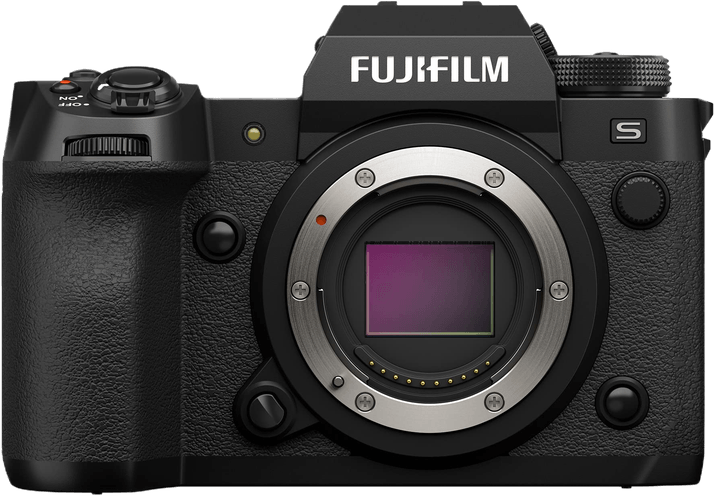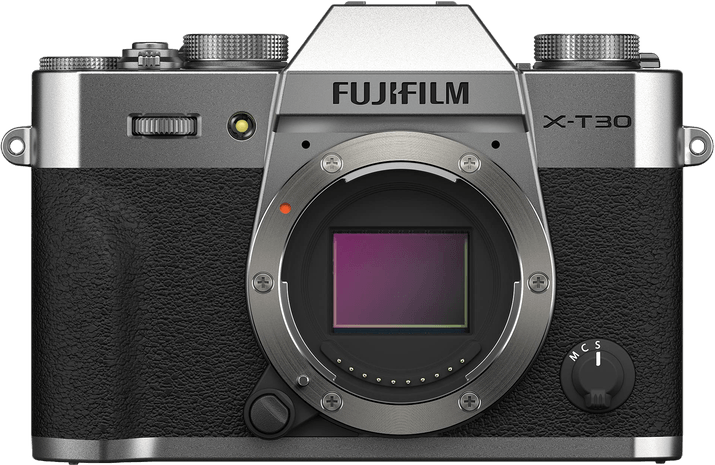Fujifilm X-H2S vs X-T30 II Comparison
Fujifilm X-H2S

Fujifilm X-T30 II

The Fujifilm X-H2S outperforms the Fujifilm X-T30 II with a score of 79/100 compared to 65/100. Both cameras share common features, such as being mirrorless and having a similar announcement and release timeline. However, the X-H2S excels with its larger size (136 x 93 x 95mm) and heavier weight (660g / 1.46lbs), providing a more substantial feel and better ergonomics for professional users.
The X-T30 II has its advantages, such as a lower launch price of $899 and a compact size (118 x 83 x 47mm) and lighter weight (383g / 0.84lbs), making it more accessible and portable for casual photographers.
Considering these factors, the Fujifilm X-H2S is the superior choice for professionals seeking advanced features and improved handling, while the Fujifilm X-T30 II offers a more budget-friendly and portable option for casual users.
Fujifilm X-H2S vs X-T30 II Overview and Optics
The Fujifilm X-H2S emerges as the winner in the optics comparison with a score of 77/100, while the Fujifilm X-T30 II trails behind at 67/100. Both cameras share several common features, such as the 26-megapixel CMOS sensor, APS-C sensor size, and Fujifilm X lens mount. Despite these similarities, the X-H2S outperforms the X-T30 II in certain aspects.
The X-H2S boasts a superior shooting speed of 40 frames per second, compared to the X-T30 II’s 30 frames per second. This increased speed allows the X-H2S to capture fast-moving subjects with greater ease and precision. Additionally, the X-H2S is equipped with the advanced X-Processor 5, while the X-T30 II uses the older X-Processor 4. This updated processor in the X-H2S contributes to faster performance and improved image quality.
One of the most significant advantages of the X-H2S is its built-in image stabilization feature. This technology helps reduce camera shake, resulting in sharper images, especially in low-light conditions or when using longer focal lengths. The X-T30 II lacks this essential feature, which could be a deal-breaker for some photographers.
However, the X-T30 II may still have some advantages. It is likely to be more compact and lightweight, making it more suitable for those who prioritize portability. Additionally, the lower price point of the X-T30 II might appeal to budget-conscious photographers.
In comparing the optics of the Fujifilm X-H2S and X-T30 II, the X-H2S clearly offers superior performance with its faster shooting speed, updated processor, and built-in image stabilization. The X-T30 II may have its merits in terms of portability and price, but for those seeking the best optics, the X-H2S is the clear choice.
Fujifilm X-H2S vs X-T30 II Video Performance
The Fujifilm X-T30 II outperforms the Fujifilm X-H2S in video capabilities, with a score of 91/100 compared to the X-H2S’s 83/100. Both cameras share some common specifications, including a 4K max video resolution, 4096 x 2160 max video dimensions, and built-in time-lapse functionality. However, the X-T30 II takes the lead with its higher max video frame rate and other advantages.
The X-T30 II’s superior video performance stems from its 120fps max video frame rate, which is double the X-H2S’s 60fps. This higher frame rate allows for smoother slow-motion footage and more detailed action shots, giving the X-T30 II an edge in video quality. Additionally, the X-T30 II may offer better image stabilization, autofocus, and color grading options, contributing to its higher video score.
The X-H2S, while not as strong in video performance, still offers respectable capabilities. Its 60fps max video frame rate is suitable for most casual videographers and its 4K resolution ensures high-quality footage. However, it does not surpass the X-T30 II in any specific video-related aspects.
Taking these factors into account, the Fujifilm X-T30 II is the clear winner in video capabilities, making it the better choice for videographers who prioritize high-quality, smooth footage and advanced video features. Meanwhile, the Fujifilm X-H2S remains a solid option for those who do not require the highest level of video performance but still want a camera with reliable 4K video capabilities.
Fujifilm X-H2S vs X-T30 II Features and Benefits
The Fujifilm X-H2S outperforms the Fujifilm X-T30 II with a feature score of 85/100 compared to 70/100. Both cameras share some common features, including a 3-inch screen, touchscreen functionality, flip screen, GPS absence, WIFI, and Bluetooth connectivity.
The X-H2S excels with a higher screen resolution of 1,620,000 dots, providing sharper and clearer image previews and better menu navigation. This advantage allows users to review images with more detail and make more accurate adjustments to settings.
On the other hand, the X-T30 II does not offer any significant advantages over the X-H2S in terms of features. Both cameras possess the same basic functionalities, but the X-H2S has a clear edge in screen resolution.
Considering these points, the Fujifilm X-H2S emerges as the superior camera in terms of features. Its higher screen resolution offers users an improved experience in image previewing and menu navigation. Meanwhile, the Fujifilm X-T30 II falls short in this aspect and does not provide any notable benefits compared to the X-H2S. Therefore, the X-H2S is the better choice for photographers seeking a camera with more advanced features and a higher-quality display.
Fujifilm X-H2S vs X-T30 II Storage and Battery
The Fujifilm X-H2S outperforms the Fujifilm X-T30 II in storage and battery with a score of 76/100, while the X-T30 II scores 35/100. Both cameras share USB charging capabilities.
The X-H2S excels with two memory card slots, accepting CFexpress Type B and SD (UHS-II Compatible) cards. Its battery life lasts for 580 shots using the NP-W235 battery type. In contrast, the X-T30 II has one memory card slot, accepting only SD/SDHC/SDXC (UHS-I compatible) cards. Its battery life is shorter at 380 shots with the NP-W126S battery type.
Though the X-T30 II falls short in comparison, its single memory card slot and shorter battery life may suffice for casual photography or users with lighter demands.
Ultimately, the Fujifilm X-H2S offers superior storage and battery performance, making it the better choice for professionals and serious enthusiasts. The Fujifilm X-T30 II can still cater to those with less demanding storage and battery requirements.
Fujifilm X-H2S vs X-T30 II – Our Verdict
Are you still undecided about which camera is right for you? Have a look at these popular comparisons that feature the Fujifilm X-H2S or the Fujifilm X-T30 II:

